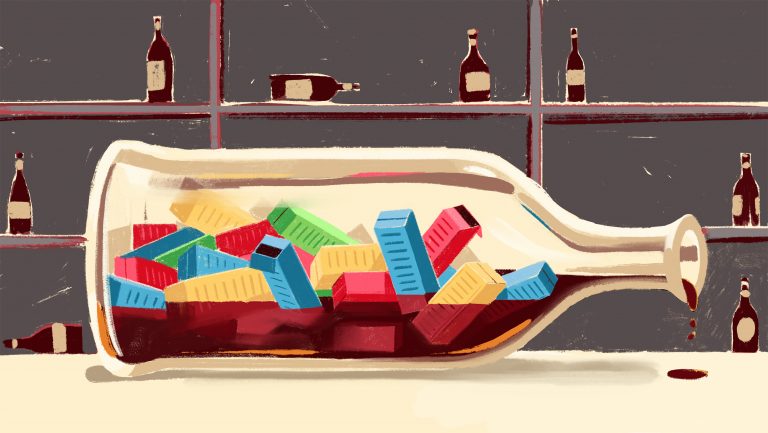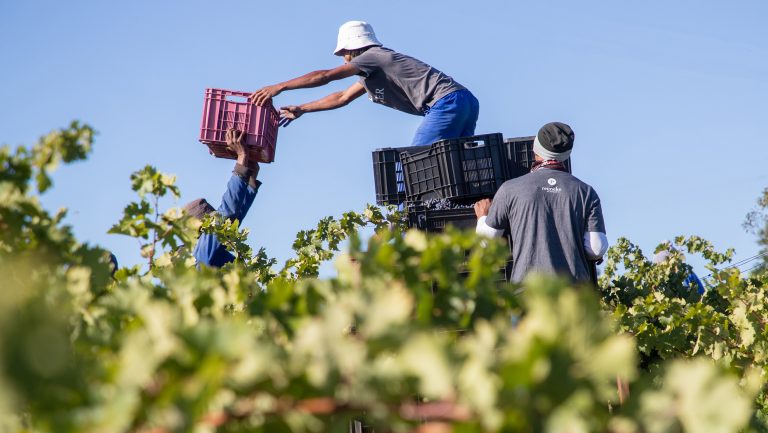When Dan DeHart founded Grander Rum eight years ago, importing a Panamanian rum to the United States seemed like a perfectly sound idea. Today, the supply chain disruptions that have plagued the industry have created enormous challenges for his operation.
“When I have products sitting in Panama fully bottled, ready to leave the country, and I’m waiting for months to get it on a ship, it’s like pulling your hair out,” he says. “You can only imagine how many ships are passing through the Panama Canal. Surely they have space for one container I can throw on there to get up to New Jersey?”
DeHart’s frustration is shared by many in the beverage alcohol industry these days. Over a year since the disruptions began, things that everyone took for granted just a few years ago—importing a wine, shipping a spirit across the United States, finding warehouse storage, getting enough glass bottles—all remain enormous, and often very costly, challenges.

Don’t miss the latest drinks industry news and insights. Sign up for our award-winning newsletters and get insider intel, resources, and trends delivered to your inbox every week.
“I would say that in the past year I’ve had more situations put in front of me where I am honestly saying, ‘Wow, I’ve never seen this before,’” says Serena Campbell, the operations director of USA Wine West in Sausalito, California. “It’s like the rule book kind of just got tossed out the window. And we’re just having to figure out a lot of stuff as we go.”
Over a year into the crisis, and with no end in sight, the industry is mobilizing in different ways. Some are taking small steps in an attempt to douse immediate, day-to-day supply chain fires; others are introducing new services designed to mitigate supply chain impacts on their customers. And as they continue to cope, some industry members have begun to address fundamental flaws in the industry’s supply chain in the hopes of preventing such a shock to the system from ever occurring again.
Where Things Stand Today
The big question at hand remains: when will these supply chain disruptions end? That forecast seems to be mixed, with some improvements reported, especially when it comes to out-of-stock items at the retail level. But most industry experts don’t expect things to return to any sense of normalcy until 2023 at the earliest.
“[I’m] sorry to report that there is no relief in sight,” says Alison Leavitt, the Portland, Maine-based managing director of the Wine and Spirits Shippers Association (WSSA). She says schedule disruption continues to be a major factor in virtually all areas, with port omissions, vessel bunching, and huge delays in transshipment ports continuing to cause significant delays. “Chaos is the new normal and we have adapted to reliable unreliability,” she adds.

Leavitt says it is hard to provide an average for today’s delays. Direct, port-to-port shipments that do not require transshipments (containers offloaded from one vessel onto another) can go perfectly, while other shipments get delayed by 30 to 90 days. “We have seen some shipments in transit for over 100 days on a route that used to average 24 to 26 days,” she says. “While there was a slight lull in the first couple weeks of January, vessels in almost all wine and spirits production areas are again at or over capacity.”
The disruptions are proving an enormous challenge for large distributors like Republic National Distributing Company (RNDC). “RNDC, our customers, and our suppliers, have all been impacted,” says Steve Feldman, the executive vice president, operations, for RNDC in Grand Prairie, Texas. Disruptions across the entire industry supply chain have created a snowball effect: Suppliers cannot get enough materials, causing product shortages for the distributor and its customers. At the same time, a shortage of trucks and drivers, poor rail service, and port congestion has resulted in delayed availability of the product that is made available from suppliers.
“This means delayed arrival of inventory and backorders to customers,” adds Feldman. “The labor crisis has exacerbated, and to a great extent contributed, to the supply chain crisis we are faced with.”
The same goes for industry service providers like the Manhasset, New York-based MHW. “The magnitude of the disruption really hasn’t changed much,” says Gabe Barkley, MHW’s CEO. “The cost of transportation is still as much as 300 percent higher than what we would consider ‘normal,’ while booking containers takes weeks of additional advanced planning. And warehouse space—especially on the East and West Coasts of the U.S.—is difficult to secure.”
While the disruptions have been taking a toll throughout the industry, smaller companies have been especially hard-hit. “You suddenly realize that the cost of shipping has tripled since early 2020,” says Nicolas Palazzi, the owner of PM Spirits in Brooklyn, New York, who has also been dealing with a laundry list of challenges, from demurrage costs (fees charged for containers that are not moved out of the port or terminal area within their allotted time frame), to lost product at warehouses. “It’s incredibly painful, it’s incredibly stressful, it’s incredibly costly.”

Difficulty obtaining a steady supply of glass bottles has been one of the largest strains on producers. For a while, the Rhode Island Spirits team, based in Pawtucket, Rhode Island, had a lack of bottles, forcing them to juggle whether to bottle their spirits immediately or store them in case an order for a more profitable item came in. In February, however, that problem then shifted to a case of “when it rains, it pours.”
“I’ve had standing orders for bottles, and now they’re all ready to be shipped now,” laughs Cathy Plourde, Rhode Island Spirits’ co-owner. “I don’t want to put off the order because God knows when I’ll run into this trouble again. And in the meantime, where the hell do I put all the bottles? And boy, this is expensive to have just sitting empty, taking up space.”
If there is a glimmer of hope, it has been seen at the retail level. “[Since mid-February], product is starting to flow again,” says Elizabeth Gregg, the general manager of Applejack Wine & Spirits in Wheat Ridge, Colorado. “We are getting some items from Europe that we have been out of for months. Fingers crossed this will continue.”
From his stores in New Jersey and Napa Valley, Gary Fisch, the founder and CEO of Gary’s Wine and Marketplace, has also noticed some improvement. “The supply chain disruptions have alleviated moderately, relative to last year,” he says. “Suppliers seem to have a better handle on projecting out supply, but it is not always accurate.”
There’s been a particular bright spot for a hands-on retailer like Fisch: “Customers have certainly become a bit more understanding,” he notes. “[Once we got] out of the crunch of the holiday season, stress levels [were] a bit lower all around.”
At Brooklyn Center Municipal Liquor Stores in Minnesota, Tom Agnes, the shop’s liquor operations manager, has also seen out-of-stocks generally loosen up. “It’s getting better now, but it’s still not where it should be,” he says. His stocks of tequila and Mexican beer, which are the workhorses of his stores, have recovered some from last year. “There were times where we would have, like, three things come in off an entire page of orders,” he notes. I’d say we’re back to about 80 percent of stock in the agave category. With [Mexican] beers, we’re probably back to 70 percent on those.”
Supply chain disruptions, along with the fits and starts of the economy, have also created choices for bars and restaurants that would have been unimaginable just a couple of years ago. At Gracia Restaurant in Seattle, bar manager Kyle Hestead says at one point their supply of tequila got so low that they were one bottle away from taking their house margarita off the menu.
Hestead took over the bar program in June 2021, just as Washington restaurants were permitted to operate at 100 percent capacity. “[This] led to a surge in demand that really exacerbated the strain we felt as a result of supply chain issues,” he says. “We went from ordering three cases of well tequila a week to six. Fortunately, the general public is pretty aware of supply chain issues so our guests have been for the most part understanding when we can’t keep certain spirits on our back bar.”

Mitigating the Impact
In many cases, supply chain disruptions—along with factors like labor shortages—have forced prices to increase. But many of the industry’s suppliers have also tried to mitigate the ongoing impacts of this crisis in other ways.
At sales and marketing company Hearts + Tales Beverage Co. in Vallejo, California, owner Kate Palmer has plans to move to third-party logistics provider Elenteny Imports, attracted by its less-than-container-load shipping (LCL) service. The LCL service combines smaller shipments from multiple parties to generate cost efficiencies for its customers; resultantly, importers can ship smaller amounts of product without tying up funds for nonessential inventory.
“[Elenteny Imports] specializes more in customer service and services people like me, who want to bring in a couple of pallets of something new and cool to see how it does before committing to bringing in 2,000 cases of something,” says Palmer, noting that outsourcing this also lets her focus on sales, marketing, and building her business. Self-managing the movement of just a few pallets through today’s overwhelmed supply chain was demanding too much of her time and resources.
Others have built more time into schedules to cushion the shipping delays. For South African wine importer Giles Thomas, the founder of Baobab Wines, one sign of just how bad things had gotten was when he had to personally pay for a truck to travel 700 miles, pick up an empty container, and bring it back to Cape Town just to ship out his wine. “We had to cover the transport costs to actually go and collect that container,” he says.
Incidents like that made him realize he had to greatly expand his lead times for shipping. “We used to factor in approximately a five-week lead time from when our wine was available to when we’d have it in our warehouse, ready to ship out the door,” he says. “During COVID, we’ve increased that to 12 to 14 weeks. So, it’s over double the time to actually get the container out of South Africa.”
Thomas also made the decision last year to invest more capital into the business to hold more inventory. “Historically we would hold probably three to four months of inventory at any one time,” he says. “And we’ve pushed that up to six or seven months now just to allow for all the supply chain delays.”
Baobab is also streamlining its portfolio, with the goal of cutting the approximately 100 wines they carry in half. “When you’re trying to manage inventory and your supply chain, the more SKUs you have the harder it is,” says Thomas. “This will allow us to focus down on the high-moving SKUs a little bit more and give those a little bit more of a push in the market.”
Along with the difficulty of finding space on a shipping container, Grander Rum’s DeHart has also been hit by skyrocketing costs of shipping and months-long delays in procuring dry goods, including barrels, closures, and labels. “The cost of freight in some cases has been double and I’ve seen it up to six [times as much]]. As a smaller producer I don’t have the buying power to negotiate my way out of this,” he says.
And, like many, he also has been plagued by difficulties obtaining 750-milliliter glass bottles. But he found some relief from the December 2020 ruling by the Alcohol and Tobacco Trade and Tax Bureau allowing 700-milliliter bottles to be used in the U.S., as he had an existing supply of 700-milliliter bottles for foreign customers. “The timing of introducing that law to allow 700[-milliliter bottles] allowed me to proceed with this bottling while maintaining my price,” he says. “It allowed me to be a little bit flexible.”

For Palazzi, at PM Spirits, the supply chain disruptions have added an extra internal labor cost: a newly created position on the payroll just to put out all the supply chain fires that arise each day. “Because there are so many issues related to everything—shipping and trucking, warehousing and deliveries—I hired somebody just to deal with these issues,” he says. “This person is in touch with everything along the supply chain.”
Hotaling & Co., an importer-distiller in San Francisco, is exploring the possibility of setting up overseas, third-party warehouses to ensure it has product ready to ship direct to distributors as longer lead times continue. “This process can alleviate some pressure during a time where increasing warehouse space is very competitive and holding excess inventory can be expensive to combat the increasing supply and transit lead times,” says Chloe Davidson, Hotaling’s supply chain manager.
Larger companies are also deploying new tools in an effort to combat the disruptions. “Our strong partnerships with key transportation companies have somewhat mitigated [product delays] and we have adjusted lead times and safety stock to reduce out-of-stocks and protect customers as best as we can,” says RNDC’s Feldman.
But the company is also going further, completing the rollout of new planning and procurement software. “Utilizing data analytics, state-of-the-art forecasting models, and advanced algorithms, we are improving our ability to ensure we have the products that support our customers’ needs,” says Feldman. “Looking at a 30- or 60-day forecast is no longer sufficient. The new technology allows us to optimize data and analytics to plan better.”
MHW is offering a Concept-to-Commercialization Program, which expands its service to earlier in the product development stage, including supply chain management and procurement of raw materials. “We actually started planning this before the pandemic,” says the company’s director of client development Chrissy Beaudette Tinelli. “I’d like to say we knew this was coming, but we had started to see tequila was already getting very popular and so was whiskey, so the market was feeling some liquid constraints. We had already built the infrastructure for it, and when the pandemic happened it made more brands feel the need for the service.”
Barkley says the disruption also gave his company an opportunity to “re-center on our core values—and to test them. As the challenges began to set in, our team was in a rapidly changing environment, and it emphasized the need for transparency in our communication with each other and with our clients. To support this transparency, we had to set proper expectations and be accountable to those expectations.”
Fixing a Broken System
Some in the industry have begun identifying the long-term structural issues that left the supply chain so vulnerable to a crisis of this magnitude in the first place. One area some identify as needing attention is warehouse visibility. During this crisis, products have made it through all the shipping and port delays, only to disappear in warehouses for weeks—if not months.
It has left some, like Baobab’s Thomas, frustrated. “Your bread and butter is being a warehouse,” he says. “You can’t inbound stocks for six weeks? You should have that operation down.”

As of February, Elenteny Imports said inventory had swollen across its third-party warehouse system by 43 percent versus the year before due to the disruptions. “That volume continues to challenge all facets of the industry: trucking, warehousing, and shipping,” says Alexi Cashen, the company’s cofounder. “It just feels like operational systems that used to work are now broken.”
She believes more visibility is needed to track inventory across the system and says the industry needs an investment in technologies to allow for more seamless visibility of product as it traverses the system.
“Had we been able to rely on real-time information, that would have definitely improved the situation,” adds Cashen. “It’s that end-to-end visibility that’s the solution. And I think our industry has a long way to go in terms of meeting that visibility.”
In the area of shipping, Leavitt says she is representing the interests of beverage alcohol shippers on the National Shipper Advisory Council formed in 2019 by Congress to advise the Federal Maritime Commission on supply chain issues. Among the issues the group will examine are what she calls “abusive” industry practices that arose during the crisis.
“The goal is to create more transparency and visibility for things like the storage charges and other [costs] importers and exporters are getting hit with that are completely out of their control,” she says. “There should be some more reasonable behavior. [Solutions] won’t happen overnight but certainly there is Congressional awareness about the situation, and there’s awareness at the Federal Maritime Commission. So, from our perspective as an Association, we are taking a leadership position on working with both government officials, and the trade to try to make improvements for the future.”
Such action will no doubt be welcomed by importers like Baobab’s Thomas, who says, “I haven’t really seen much accountability from anyone in the supply chain when things have gone wrong. It’s just been kind of like, throw it back to the customer. Which I found a little bit surprising and disappointing.”
Leavitt says the recently passed Infrastructure Investment and Jobs Act may help as well. “Eventually. There are significant dollars dedicated to ports, terminals, roads, bridges—but these improvements will take time,” she says.
And yet, with the summer fast approaching followed by the busiest shipping season of the year, October, November, December, fast on its heels, time is also something in short supply.

Dispatch
Sign up for our award-winning newsletter
Don’t miss the latest drinks industry news and insights—delivered to your inbox every week.
Andrew Kaplan is a freelance writer based in New York City. He was managing editor of Beverage World magazine for 14 years and has worked for a variety of other food and beverage-related publications, and also newspapers. Follow him on Twitter at @andrewkap.







